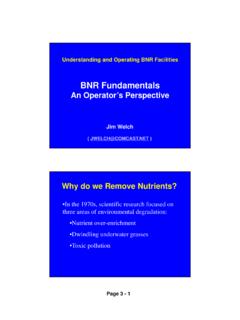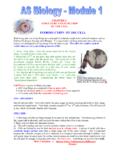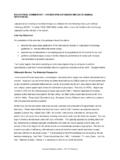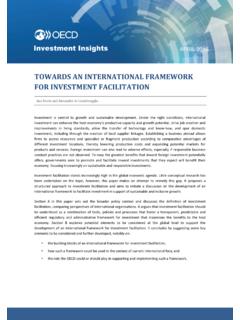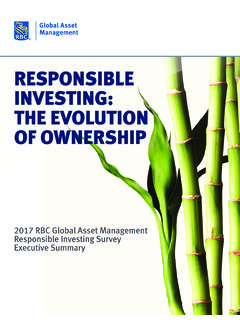Transcription of Aerobic Digestion for the 21 Century - Main Page | …
1 Aerobic Digestion for the 21stCenturyPresentation OverviewAbout Aerobic DigestionAerobic Digestion ImprovementsAerobic Digestion in the Real World2 Digestion Expertise3 WEFTEC 1997 2001 VOL II I 1999 WORKSHOPDIGESTIONAEROBICFine Tunin gthe Controll edAerobic Di gestionProc essClass BOf MeetingWhile DigestingThicker Slu dgesThe ChallengeVOL I 1997WO RKSH OPDIGESTIONAEROBICCD-ROMD igestion Expertise4 MOP 11 Operation of Municipal WWTPV olume III: Solids ProcessesChapter 31: Aerobic DigestionAuthor: Elena BaileyDigestion Expertise5 MOP No. 8 5thEd., 2009 Design of Municipal WWTPsVolume III: Solids Processing and ManagementChapter 25: StabilizationSection 3 : Aerobic DigestionAuthor: Miguel VeraAbout Aerobic Digestion6 What is Aerobic Digestion ?
2 Aerobic Digestion is a process to:1. Reduce the quantity of sludge for disposal. Bacteria continue metabolism as they do in the liquid process but without new food they use their own biomass (endogenous respiration).2. Stabilize the sludge so that it is safer for human contact, does not attract vermin (vectors), and odors are is Aerobic Digestiontypically used?1. When it is required by local regulatory agencies2. When the facility will be land applying their biosolids and needs to meet Class B When the facility wants to reduce the volume of sludge for final disposal4. When there are concerns about odors5. When there is no primary sludge (think BNR)8 Pluses and minuses of Aerobic DigestionPluses1. Inherently safer than anaerobic digestion2.
3 Lower capital cost compared to anaerobic digestion3. Ease of operationMinuses1. Higher energy costs2. Temperature sensitive910 Aerobic Digestion ChemistryAerobic Digestion is a biological process similar to Activated Sludge. Activated Sludge = GrowthAerobic Digestion = DecayProcess control is required to maintain healthy biomass11 biological Processes1. Digestion :C5H7NO2+ 5O2= 4CO2+ H2O + (NH4 HCO3)Biomass Ammonium Carbonate2. Nitrification:NH4++ 2O2 = H2O + 2H++ NO3 Ammonia AcidNitrate3. Digestion with Nitrification:C5H7NO2+ 7O2= 5CO2+ 3H2O + HNO3 Biomass Nitric Acid12 biological Processes4. Digestion with Nitrification:C5H7NO2+ 7O2= 5CO2+ 3H2O + HNO3 BiomassNitric Acid5. Denitrification:C5H7NO2+ 4NO3 + H2O = NH4++5 HCO3 + 2N2 BiomassNitrate Ammonia N GasAlkalinity6.
4 Complete Nitrification / Denitrification:C5H7NO2+ 5CO2+ + N GasFactors affecting the rate of Digestion :1. Temperature 2. pH3. Stability of the sludge4. biological diversityTraditional Digester DesignPrior to Class B Requirement10 20 Days SRT (M&E, 1991)Mixing Air 30 scfm/1,000 cfNo Performance Requirements14503 Regs Change the Game15 Aerobic Digestion Regulatory Requirements40 CFR Part 5031. Class B with respect to Pathogens: 60 Days @ 15 C or 40 Days @ 20 COR Pathogens 2,000,000 CFU2. Class B with respect to Vector Attraction Reduction Volatile Solids Reduction 38% OR SOUR mg/L O216 Aerobic Digestion Regulatory Requirements (cont.)170%10%20%30%40%50%60%VSS Destruction (%)0 200 400 600 800 1000 1200 1400 1600 1800 2000 Temp-SRT (deg.)
5 C-day)18 Aerobic Digestion Chemistry18% Oxygen Savings:3. Digestion with Nitrification:C5H7NO2+ 7O2= 5CO2+ 3H2O + HNO3 Versus6. Complete Nitrification / Denitrification:C5H7NO2+ 5CO2+ + Digestion ChemistrypH Cycle:1. Digestion : (pH UP)C5H7NO2+ 5O2= 4CO2+ H2O + NH4++ HCO3 2. Nitrification: (pH DOWN)NH4++ 2O2 = H2O + 2H++ NO3 4. Denitrification:(pH UP)C5H7NO2+ 4NO3 + H2O = NH4++ 5 HCO3 + 2N2 Aerobic Digestion ChemistryNitrogen Cycle:1. Digestion :C5H7NO2+ 5O2= 4CO2+ H2O + NH4++ HCO3 2. Nitrification: NH4++ 2O2 = H2O + 2H++ NO3 4. Denitrification:C5H7NO2+ 4NO3 + H2O = NH4++ 5 HCO3 + 2N2 Aerobic Digestion Temperature Optimum Range: 20 C 30 C Rate (10 C) Rate (20 C) Nitrification stops at 5 CTechniques to Improve ProcessPerformance221.
6 Series or Batch Operation 2. Sludge Thickening3. Aerobic & Anoxic Operation4. Temperature Control5. Operational Flexibility1. Series / Batch Operation23 Advantages: Reduces short circuiting of partially digested sludge Requires 50% less volume to achieve same volatile solids reductionSeries / Batch OperationClyde, OH MGD WWTP2. Thickening25 Advantages: Smaller digesters Less digested sludge Higher sludge SolidsDate of MeasurementTotal Digester Solids ConcentrationHauling Cost Savings40%Hauling Cost Savings60%Hauling Cost Savings60%Previous Maximum Concentration = Aerobic / Anoxic Operation27 Advantages: Reduce O2requirements by 18% Preserve alkalinity Reduce total nitrogenAerobic / Anoxic OperationBellville, TX MGD WWTPE ffect of AO/AX on VSRRef.
7 : I. Al Ghusain, et. al., Environmental Technology, Vol. 25, 2004T = 20C, SRT = 10 d4. Temperature Control30 Advantages: Increased Digestion rate Maintains healthy biomass Provides consistent operation and performance year aroundEffect of Temp on VSRRef.: I. Al Ghusain, et. al., Environmental Technology, Vol. 25, 2004 SRT = 10 dAnoxic Cycle = 8 hr32 Designs should incorporate the following as much as possible: Ability to control sludge thickness in digesters Ability to control air flow to each basin Ability to monitor pH, DO, & T5. FlexibilityAerobic Digestion Improvements33 Effects of Thickening on Aeration1. Lowering of alpha values2. Mixing is as important as aeration3. Seasonal thinningmay be necessary6/13/2014 Product Features35 Above Water OrificingEase of Access37 The Diffuser in Action38 Improved Mixing Ability3940 Oxygen Transfer Efficiency4%6%8%10%12%14%16%681012141618 20 Oxygen Transfer EffeciencySubmergence Depth (ft)Diffuser Performance CurvesTransMax and MSTransMaxMSAirflow Rate:15-25 scfm/diffuserTMMSTank GeometryAbilities of the single drop diffuser must be kept in mind1.
8 Oxygen transfer efficiency improves with depth2. Mixing ability increases with depth as well3. Varying sidewater depths can be problematic for shear tubes, blowers, and header arrangements 6/13/2014G TAD Process42G TADstands for:Gravity Thickened Aerobic DigestionGravity Thickener43 Aerobic Digester44 Working Together45G TAD Process FlowPre Mix11. Waste sludge is pumped into Pre mixG TAD Process FlowPre MixGravityThickener212. Sludge flows into Gravity ThickenerG TAD Process FlowIn LoopDigesterPre MixGravityThickener21343. Thickened sludge airlifted into Digester4. Nitrified sludge overflows into Pre mixG TAD Process FlowIn LoopDigesterPre MixGravityThickener2134565. Scum airlifted into Digester6. Supernatant returned to head of plantG TAD Process FlowIsolatedDigesterIn LoopDigesterPre MixGravityThickener21345767.
9 Class B sludge removed for disposalG TAD Batch Operating CycleDIGESTER #1 CYCLEDIGESTER #2 CYCLEFeed StageDay 1 2 Fill Digester #1 Day 3 14 In loop ThickeningBatch StageDay 15 26 Isolation Day 27 28 Draw downBatch StageDay 1 12 IsolationDay 13 14 Draw DownFeed StageDay 15 16 Fill Digester #2 Day 17 28 In loop ThickeningG TAD Process52G TAD Installation ReferencesLocationDesign FlowPlant ConfigurationCommission DateStockbridge, MGDSBR2002 Belleville, MGDC omplete Mix2002 Clermont, MGDO xidation Ditch2002 Gardner, MGDO xidation Ditch2003 Woodland, MGDSBR2003 Myrtle Creek, MGDO xidation Ditch2004 Shelton, MGDO xidation Ditch2004 Amherst, MGDO xidation Ditch2004 Blue Mtn.
10 Lake, MGDRBC2004 Brenham, MGDC omplete Mix2004M TAD Process53M TADstands for:Mechanical Thickened Aerobic DigestionM TAD Process54 The PAD M process enhanced Digestion process to achieve guaranteed Class B biosolids with conventional equipment in a reduced volume, using less VOLUMEVOLATILE SOLIDS REDUCTIONENSURESPATHOGENREDUCTIONMECHANI CAL THICKENERAIRAIRAIROPTIONAL STORAGEDIGESTER 1 DIGESTER 2M TAD Process55 Thickened SludgeRaw SludgeMechanical ThickenerFiltrateAerobic Digester No. 1 Aerobic Digester No. 2 Aerobic Digester No. 3 Optional Cover for Temp. B Digested SludgeDiffusers with Shear Tubes6/13/2014 Diffusers with Draft Tube6/13/2014M TAD Process58 LocationDesign FlowPlant ConfigurationThickening MethodClyde, DitchGBTLos Lunas, , & 2 SludgeGBT/BFPM yrtle Beach, Aer.





